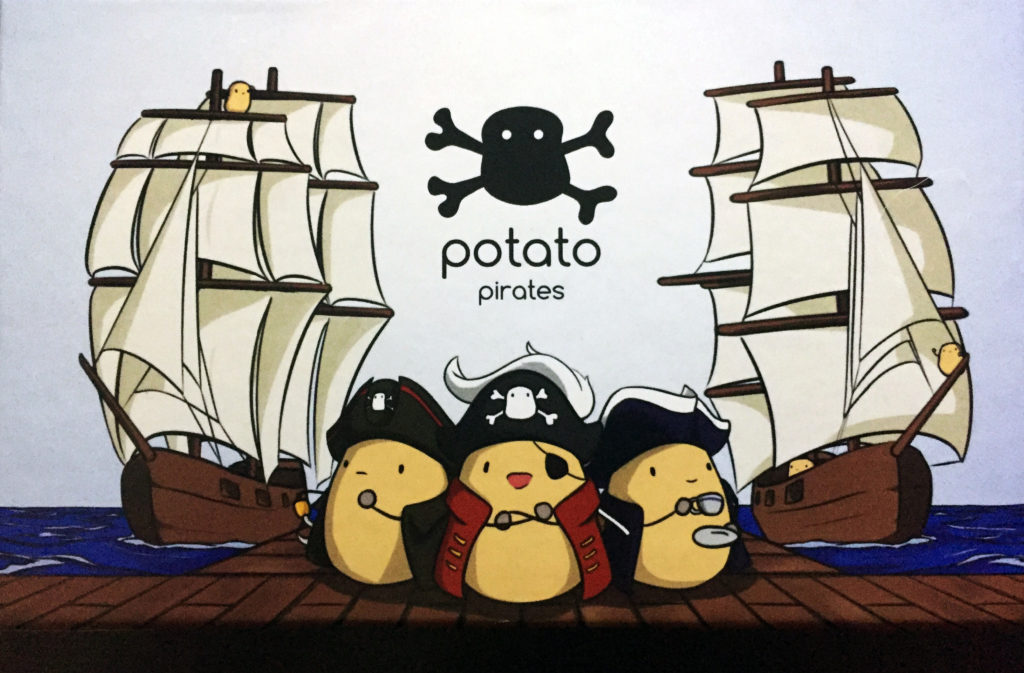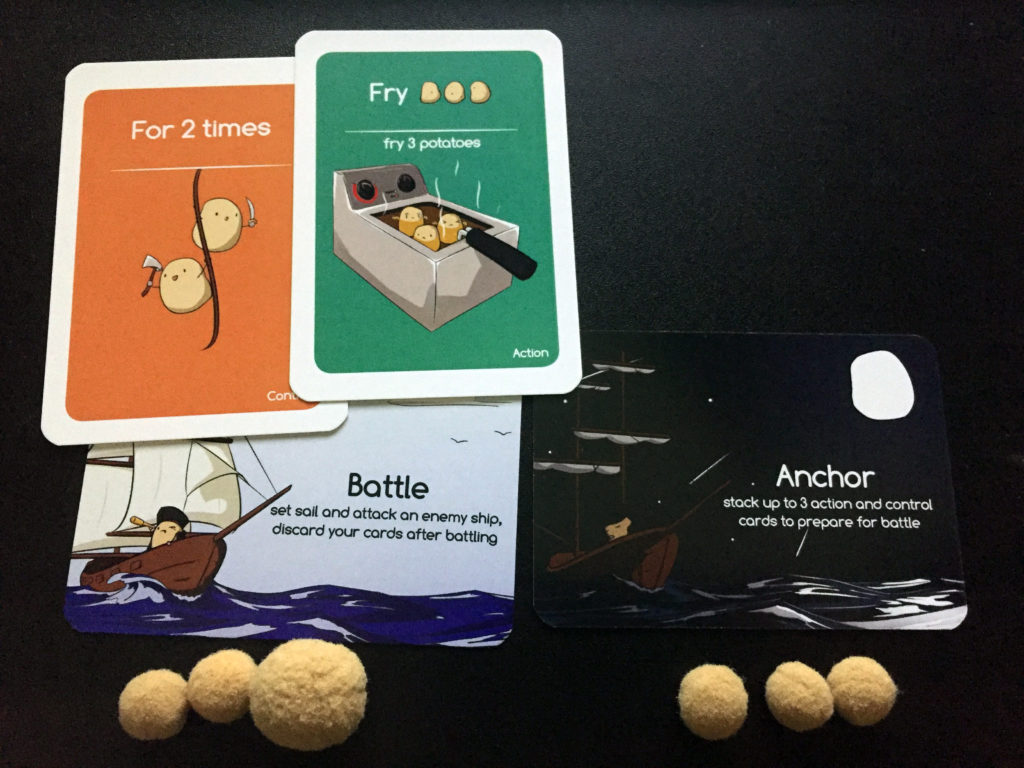Arrrrrrrrrrr, Matey! We be here today t’ loot a look “Potato Pirates”, a card game that’ll be seekin’ fundin’ through th’ Kickstarter process in late Augusy\t / Early September o’ 2017. In this three t’ six player adventure, ye’ll be tasked wit’ either acquirin’ all seven o’ th’ Potato Kin’ cards or eliminating all o’ th’ other players from th’ game. Okay, I’m done with the pirate talk, I swear. Special thanks to the folks at Codomo for providing me with a prototype copy for preview purposes. It’s important to stress that prototypes are not always reflective of the final product, making everything that you see and read about below (including the rules) subject to change.

“Potato Pirates” markets itself as a game that has potatoes, pirates, and programming…yes, you heard that right. I can confirm that it has all three, though the bit about the programming isn’t as intimidating as it sounds (more on that later). My prototype copy came with 18 ship (battle/anchor) cards, 85 playing cards, and a cloth baggie filled with small & large tan balls (representing crew members). The box wasn’t large enough to hold the instructions though I imagine the final production copy will. To set up the game, each player receives to ship cards (anchor side up), twenty potato crew members (ten on each ship, 1 large potato = 5 small potatoes), and a hand of five playing cards.
There are four types of cards in the deck: 1) Action cards, 2) Control cards, 3) Bug cards, and 4) Surprise cards. Action cards can only be played on a ship when it’s anchored and can be stacked with other cards to perform powerful attacks. For example, the “Fry” action card inflicts three potatoes worth of damage to an enemy ship. For every damage that is inflicted, the enemy player loses a potato crew member. While action cards are pure, raw damage, control cards boost them in many ways. “While” cards, for example, repeat an attack until the listed condition is no longer true. “If, Else” cards have two separate load-outs, one for the IF side and one for the ELSE side. The third type of card in the deck, bug cards, are played immediately face-up. Collect all seven and win the game! The last type of card, surprise cards, can be played at any time (like interrupt cards in other popular card battlers).
At the beginning of a player’s turn they’ll draw two cards from the deck. After that, for each ship they own, they can either build or run your attack. You cannot perform both actions with the same ship. When building, you’ll play cards from your hand onto the ship, though it can only hold up to three action/control cards. Crew members can also be shuffled among the ships (except for those in battle mode). Speaking of which, running an attack simply means that you’re flipping the ship over from anchor mode to battle mode to attack. Once the attack is over, all played cards on that ship are discarded. It goes back into anchor mode automatically at the beginning of that person’s next turn.

Some of the above might sound complicated, though I assure you it isn’t. The most thinking I ever had to do was figuring out how to best chain cards together. For example, a “While >4 Potatoes” control card and a “Fry – 3 Damage” action card, when used together on an attack, allows the attacker to continue doing three damage to an enemy ship until it has less than four potatoes remaining on that ship. That’s a great move if your opponent is concentrating all of their crew onto one ship. I found that a combination of one to two control cards and one action card works best. Of course, the very simple “For 3 Times” combined with an action card will inflict that amount of damage three times.
Players who have a crew but no ship (it’s possible to lose a ship to another player via “Hijack” surprise cards) have until the end of their next turn to purchase one (four potato crew members) or hijack one or they are eliminated. Likewise, if a ship has no crew, it sinks. If a player is eliminated, the player who knocks them out gets any cards in their hand as well as any potato king cards they may have in front of them. What path to victory will you choose? Knocking out the enemy one by one or strategically gunning for any king potato cards that come up? No matter what, you’ll have to load those cannons as combat is most assuredly unavoidable.
I personally enjoyed my time with “Potato Pirates”. While it does have a family-friendly theme, I am concerned that younger/immature players may resent being the target on a regular basis. It’s easy to single someone out for no good reason. For that reason, I’d recommend a house rule stating that a player cannot attack the same player twice on the same turn or possibly on two consecutive turns. This obviously wouldn’t apply if there are only two players left, but I think you get the idea. With that said, I was incredibly relieved to find out how simple the programming portion was…here I was expecting to Google C++ or something. While I do remember loops from my time with Basic back in the day, I wouldn’t (and shouldn’t) be trusted doing much else.
I hope you’re hungry for some mashed potatoes, as you’ll be making plenty of it while playing “Potato Pirates“. While the box indicates that the game is for three to six players, you could play with two. With that said, games are much more enjoyable with three or more as two player games tend to be over very quickly (in my experience).
Kickstarter: https://www.kickstarter.com/projects/codomo/potato-pirates-the-tastiest-coding-card-game
—
